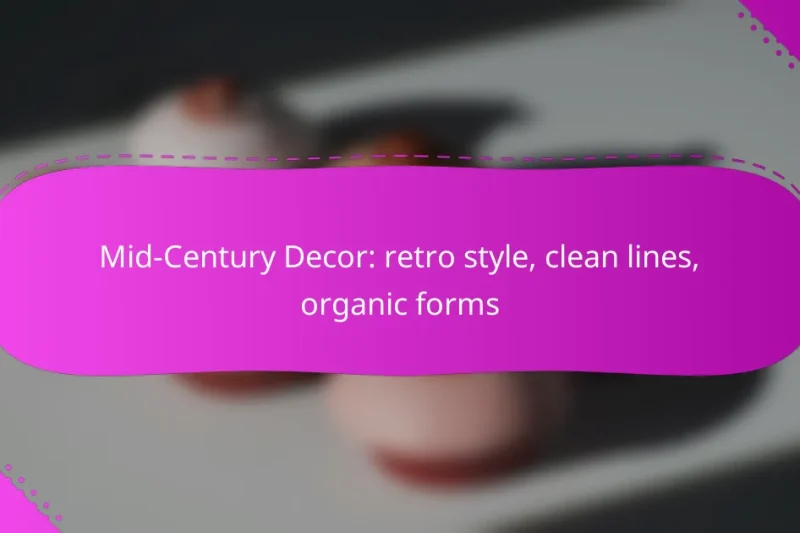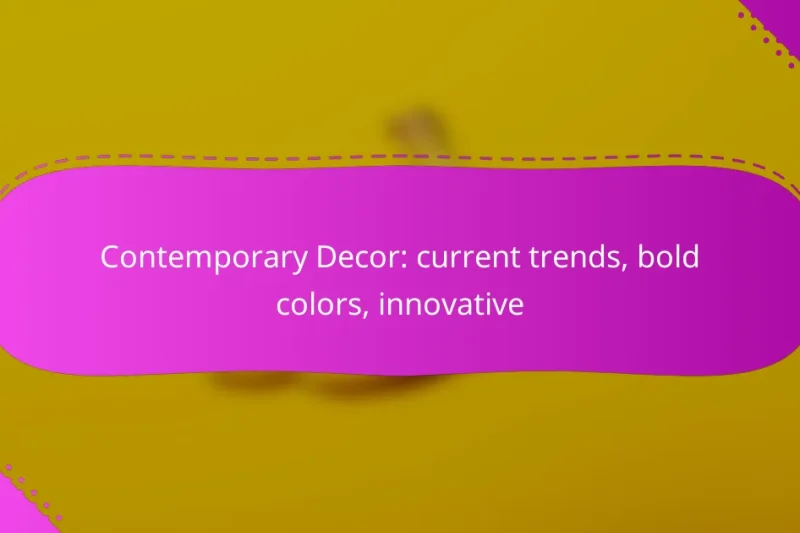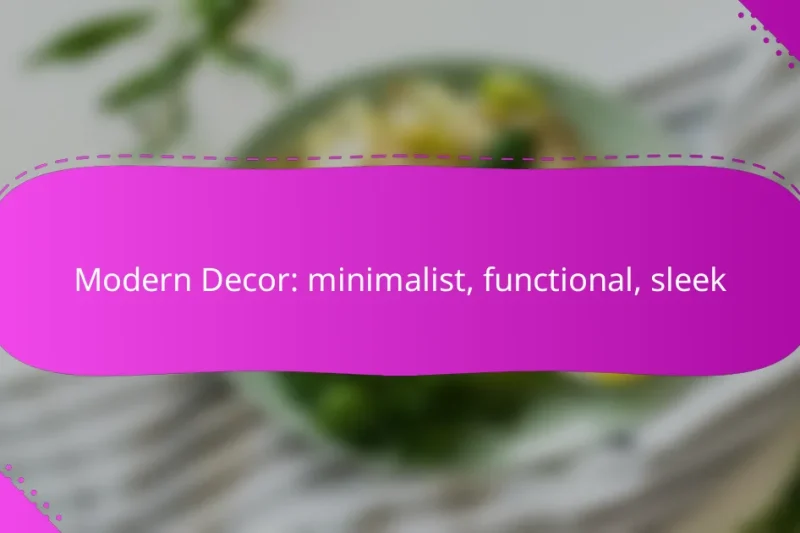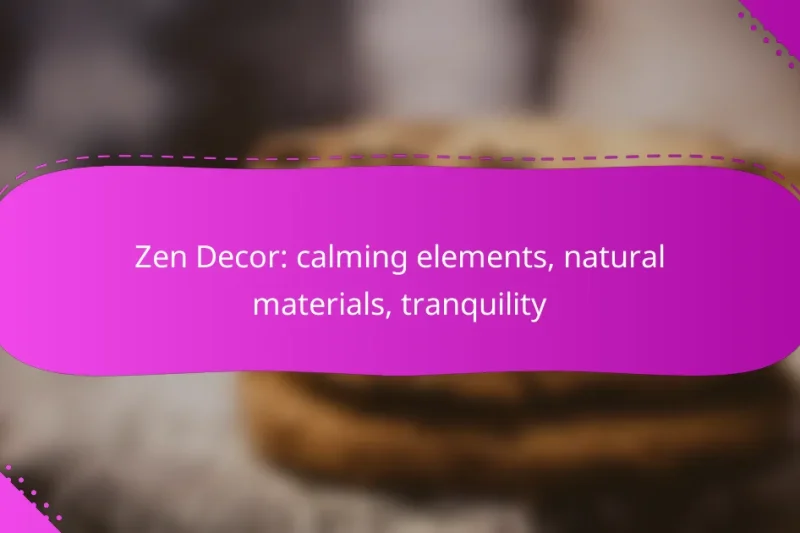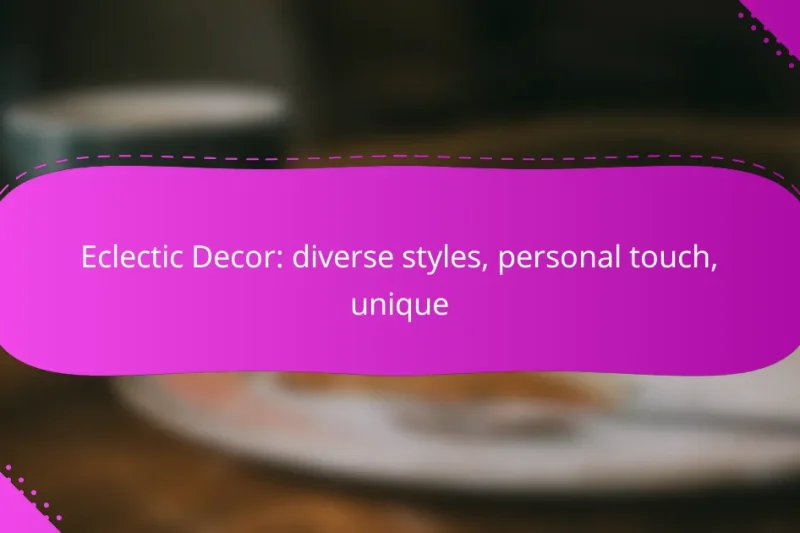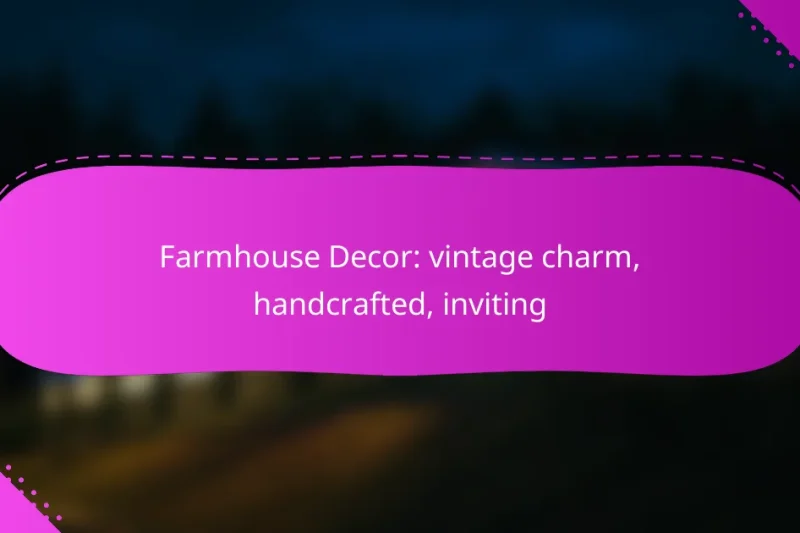Mid-Century decor is a timeless design style characterized by its clean lines and organic forms, making … Mid-Century Decor: retro style, clean lines, organic formsRead more
Choosing the Right Decor Style for Your Home
Choosing the right decor style for your home is a crucial step in creating a space that reflects your personality and meets your lifestyle needs. With a variety of popular styles such as Modern Minimalism, Rustic Farmhouse, and Scandinavian Design, it’s essential to explore these options and identify what resonates with you. By understanding the unique elements of each style, you can make informed decisions that enhance your living environment.
Coastal Decor: airy feel, ocean colors, relaxed atmosphere
Coastal decor brings the essence of the beach into your home, creating a serene and relaxed … Coastal Decor: airy feel, ocean colors, relaxed atmosphereRead more
Contemporary Decor: current trends, bold colors, innovative
Contemporary decor is currently defined by bold colors and innovative designs that prioritize both aesthetics and … Contemporary Decor: current trends, bold colors, innovativeRead more
Modern Decor: minimalist, functional, sleek
Modern decor embraces a minimalist approach that highlights simplicity, functionality, and sleek aesthetics. By incorporating elements … Modern Decor: minimalist, functional, sleekRead more
Rustic Decor: natural materials, warm colors, cozy feel
Rustic decor brings the warmth of nature into your home through the use of natural materials … Rustic Decor: natural materials, warm colors, cozy feelRead more
Zen Decor: calming elements, natural materials, tranquility
Zen Decor transforms living spaces into serene retreats by emphasizing simplicity and natural materials that foster … Zen Decor: calming elements, natural materials, tranquilityRead more
Scandinavian Decor: simplicity, light colors, practicality
Scandinavian decor embodies a harmonious blend of simplicity, functionality, and light colors, creating serene and inviting … Scandinavian Decor: simplicity, light colors, practicalityRead more
Bohemian Decor: vibrant patterns, eclectic mix, artistic flair
Bohemian decor is a celebration of individuality, characterized by vibrant patterns, an eclectic mix of furnishings, … Bohemian Decor: vibrant patterns, eclectic mix, artistic flairRead more
Eclectic Decor: diverse styles, personal touch, unique
Eclectic decor is all about blending diverse styles, colors, and textures to craft a space that … Eclectic Decor: diverse styles, personal touch, uniqueRead more
Farmhouse Decor: vintage charm, handcrafted, inviting
Farmhouse decor beautifully combines vintage charm with handcrafted elements to create an inviting atmosphere. By selecting … Farmhouse Decor: vintage charm, handcrafted, invitingRead more
What are the popular decor styles in the UK?
In the UK, popular decor styles include Modern Minimalism, Rustic Farmhouse, Scandinavian Design, Industrial Chic, and Traditional English Country. Each style offers unique characteristics and aesthetics, allowing homeowners to express their personal taste and create inviting spaces.
Modern Minimalism
Modern Minimalism focuses on simplicity and functionality, often featuring clean lines and a neutral color palette. This style emphasizes decluttering and the use of essential furnishings, creating a serene and open environment.
To achieve a minimalist look, choose furniture with sleek designs and limit decorative items. Incorporating natural light and open spaces enhances the minimalist aesthetic, making rooms feel larger and more inviting.
Rustic Farmhouse
Rustic Farmhouse decor combines charm and comfort, often utilizing natural materials like wood and stone. This style embraces a cozy, lived-in feel, with vintage accents and a warm color scheme that evokes a sense of nostalgia.
To create a Rustic Farmhouse look, consider using reclaimed wood for furniture and decor. Soft textiles, such as plaid or linen, can add warmth, while open shelving displays rustic kitchenware or handmade crafts.
Scandinavian Design
Scandinavian Design is characterized by simplicity, functionality, and a connection to nature. This style often features light colors, natural materials, and an emphasis on minimalism, creating a bright and airy atmosphere.
Incorporate elements like wooden furniture, soft textiles, and plenty of natural light to achieve this look. Adding greenery, such as potted plants, can enhance the organic feel typical of Scandinavian interiors.
Industrial Chic
Industrial Chic decor draws inspiration from warehouses and factories, showcasing raw materials and an urban aesthetic. This style often includes exposed brick, metal accents, and open spaces, creating a modern yet rugged look.
To embrace Industrial Chic, opt for furniture with metal frames and reclaimed wood. Incorporating vintage lighting fixtures and large artwork can enhance the industrial vibe while adding character to the space.
Traditional English Country
Traditional English Country decor reflects a classic and timeless style, often featuring floral patterns, rich colors, and antique furnishings. This style emphasizes comfort and elegance, creating a welcoming and homely atmosphere.
To achieve this look, use patterned wallpaper, plush fabrics, and traditional wooden furniture. Incorporating elements like a cozy fireplace or a well-stocked bookshelf can enhance the inviting nature of English Country decor.
How to choose a decor style for your home?
Choosing a decor style for your home involves identifying your preferences, understanding your space, and aligning your choices with your lifestyle. Start by exploring various styles and narrowing down what resonates with you while considering practical aspects of your living environment.
Assess your personal taste
Your personal taste is the foundation of your decor style. Consider what colors, patterns, and materials you are naturally drawn to. Look through magazines, websites, or social media platforms for inspiration and create a mood board to visualize your preferences.
Pay attention to the elements that make you feel comfortable and happy. Whether you lean towards modern minimalism, rustic charm, or eclectic designs, your home should reflect your individuality.
Consider your home’s architecture
The architecture of your home plays a crucial role in determining the appropriate decor style. Traditional homes may benefit from classic or vintage decor, while modern structures often suit contemporary or industrial styles. Analyze the features of your home, such as ceiling height, window styles, and overall layout.
Incorporate elements that complement your home’s architecture. For instance, if you have exposed brick walls, consider a loft-style decor that enhances that feature rather than covering it up.
Evaluate your lifestyle needs
Your lifestyle significantly influences your decor choices. Consider how you use your space and what activities take place in each room. If you have children or pets, opt for durable materials and practical layouts that can withstand wear and tear.
Think about your daily routines and how your decor can enhance them. For example, if you enjoy entertaining, create open spaces with comfortable seating arrangements. Prioritize functionality without sacrificing style to ensure your home meets your needs effectively.
What are the key elements of each decor style?
Each decor style is defined by its unique elements, including color palettes, furniture types, and textile choices. Understanding these components helps you select a style that resonates with your personal taste and complements your living space.
Color palettes
Color palettes are fundamental to establishing the mood of a decor style. For example, a minimalist style often features neutral tones like whites and grays, while bohemian designs embrace vibrant, earthy colors. Consider how colors interact with natural light in your home to enhance the overall atmosphere.
When choosing a color palette, aim for harmony and balance. A good rule of thumb is to use a primary color for walls, a secondary color for larger furniture, and accent colors for decor items. This approach creates a cohesive look without overwhelming the space.
Furniture types
The type of furniture you select plays a crucial role in defining your decor style. Traditional styles often feature ornate wooden pieces, while contemporary designs lean towards sleek, functional furniture. Assess your space and lifestyle to determine what furniture types will best suit your needs.
Additionally, consider scale and proportion. Large, bulky furniture can overwhelm smaller rooms, while delicate pieces may get lost in larger spaces. Aim for a mix of sizes to create visual interest and ensure comfort.
Textile choices
Textiles add warmth and texture to your home, enhancing the overall decor style. For instance, a coastal theme may incorporate light, airy fabrics like linen and cotton, while a rustic style might favor heavier materials such as wool and burlap. Choose textiles that complement your chosen color palette and furniture types.
When selecting textiles, think about durability and maintenance. Natural fibers often offer longevity but may require more care, while synthetic options can be easier to clean. Balance aesthetics with practicality to ensure your choices work for your lifestyle.
How to mix and match decor styles effectively?
Mixing and matching decor styles involves combining different design elements to create a cohesive look. To do this effectively, focus on identifying common themes, using a unifying color scheme, and balancing proportions throughout your space.
Identify common elements
Start by pinpointing shared features among the styles you wish to combine. Look for similar shapes, materials, or textures that can serve as a bridge between different designs. For example, if you have a modern sofa, you might pair it with vintage accent chairs that share a common color or material.
Consider the overall mood you want to create. Whether it’s rustic, industrial, or contemporary, ensure that the elements you choose resonate with that theme. This will help maintain a sense of harmony in your decor.
Use a unifying color scheme
A consistent color palette is crucial when mixing decor styles. Select a few key colors that will appear across all elements in the room. This can be done through wall paint, furniture, and accessories. For instance, if you choose a neutral base with pops of color, it can tie together various styles seamlessly.
When selecting colors, consider the emotional impact they have. Warm tones can create a cozy atmosphere, while cool tones may lend a more serene feel. Aim for a balance that reflects your personal style while ensuring all elements feel connected.
Balance proportions
Proportion plays a significant role in how different styles interact. Ensure that the size of furniture and decor items is appropriate for the space and each other. For example, pairing a large, bulky piece with smaller, delicate items can create visual tension that may not be appealing.
To achieve balance, consider the scale of each element. A good rule of thumb is to mix large and small items in a way that feels intentional. For instance, if you have a large artwork, complement it with smaller decorative objects that enhance its presence without overwhelming the space.
What are the current decor trends in the UK?
Current decor trends in the UK emphasize sustainability, natural elements, and a blend of comfort with style. Homeowners are increasingly opting for designs that reflect personal values and a connection to nature.
Sustainable materials
Sustainable materials are gaining popularity in UK home decor as people become more environmentally conscious. Options such as reclaimed wood, bamboo, and recycled metals not only reduce waste but also add unique character to spaces.
When choosing sustainable materials, consider their source and lifecycle. Look for certifications like FSC (Forest Stewardship Council) for wood products, ensuring they come from responsibly managed forests. This approach not only supports eco-friendly practices but can also enhance the aesthetic appeal of your home.
Biophilic design
Biophilic design integrates natural elements into interior spaces, fostering a connection to the outdoors. This trend often includes large windows, indoor plants, and natural light to create a calming environment that promotes well-being.
To incorporate biophilic design, consider adding features like living walls or using natural textures in furnishings. Simple additions such as potted plants or nature-inspired artwork can significantly enhance the ambiance and improve air quality in your home.
